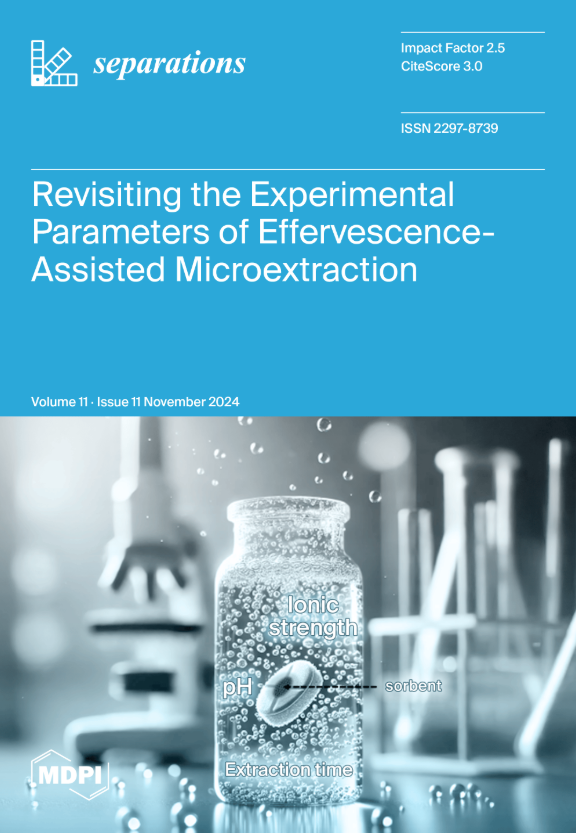熏制过程对传统干腌腊肠中生物胺含量的影响
IF 2.5
4区 工程技术
Q3 CHEMISTRY, ANALYTICAL
引用次数: 0
摘要
本研究旨在调查不同生产阶段对传统干腌辣香肠的质量和变质条件的影响。为此,我们采用了一种实验设计,考察了三个关键的生产参数:批次、灌装阶段和食品熏制过程。这项研究是与当地的一家生产商合作进行的,该生产商坚持使用橡木烟熏和加热的传统腌制方法。在整个过程中,对生物胺的含量进行了密切监测。其中包括通过盐析技术对生物胺进行提取和衍生,然后分别使用 LC-ESI/MSn 和 HPLC-DAD 进行鉴定和定量。研究结果表明,在灌装阶段,原材料和生产过程都得到了很好的控制。然而,14 天的橡木熏制期显然对生物胺的形成有显著影响,其总平均值从 126 毫克/公斤-1 增加到 1385 毫克/公斤-1,尤其是腐胺(PUT)、尸胺(CAD)和酪胺(TYR),尽管这些含量仍低于口服毒性限值(2000 毫克/公斤-1)。因此,这些化合物的浓度会影响传统干制腊肠的质量和安全性。因此,PUT、CAD 和 TYR 的综合含量可以作为这些产品的重要质量指标。本文章由计算机程序翻译,如有差异,请以英文原文为准。
Impact of the Smoking Process on Biogenic Amine Levels in Traditional Dry-Cured Chorizo
This study aimed to investigate the influence of various production stages on the quality and spoilage conditions of traditionally dry-cured chorizo. To accomplish this, we employed an experimental design that examined three key production parameters: the batch, the filling stage, and the food smoking process. The study was conducted in collaboration with a local producer who adheres to traditional curing methods utilizing oak wood smoke and heat. Biogenic amine levels were closely monitored throughout the process. This involved their extraction and derivatization through the salting-out technique, followed by identification and quantification using LC-ESI/MSn and HPLC-DAD, respectively. The findings suggest that both raw materials and the production process are well controlled during the filling stage. However, it became evident that the 14-day oak wood smoking period had a significant impact on biogenic amine formation, whose total mean values increased from 126 to 1385 mg kg−1, particularly with respect to putrescine (PUT), cadaverine (CAD), and tyramine (TYR), although these levels remained below the oral toxicity limit (2000 mg kg−1). Consequently, the concentration of these compounds can influence the quality and safety of traditionally dry-cured chorizos. Therefore, the combined levels of PUT, CAD, and TYR can serve as a valuable quality indicator for these products.
求助全文
通过发布文献求助,成功后即可免费获取论文全文。
去求助
来源期刊

Separations
Chemistry-Analytical Chemistry
CiteScore
3.00
自引率
15.40%
发文量
342
审稿时长
12 weeks
期刊介绍:
Separations (formerly Chromatography, ISSN 2227-9075, CODEN: CHROBV) provides an advanced forum for separation and purification science and technology in all areas of chemical, biological and physical science. It publishes reviews, regular research papers and communications. Our aim is to encourage scientists to publish their experimental and theoretical results in as much detail as possible. There is no restriction on the length of the papers. The full experimental details must be provided so that the results can be reproduced. There are, in addition, unique features of this journal:
Manuscripts regarding research proposals and research ideas will be particularly welcomed.
Electronic files and software regarding the full details of the calculation and experimental procedure, if unable to be published in a normal way, can be deposited as supplementary material.
Manuscripts concerning summaries and surveys on research cooperation and projects (that are funded by national governments) to give information for a broad field of users.
The scope of the journal includes but is not limited to:
Theory and methodology (theory of separation methods, sample preparation, instrumental and column developments, new separation methodologies, etc.)
Equipment and techniques, novel hyphenated analytical solutions (significantly extended by their combination with spectroscopic methods and in particular, mass spectrometry)
Novel analysis approaches and applications to solve analytical challenges which utilize chromatographic separations as a key step in the overall solution
Computational modelling of separations for the purpose of fundamental understanding and/or chromatographic optimization
 求助内容:
求助内容: 应助结果提醒方式:
应助结果提醒方式:


